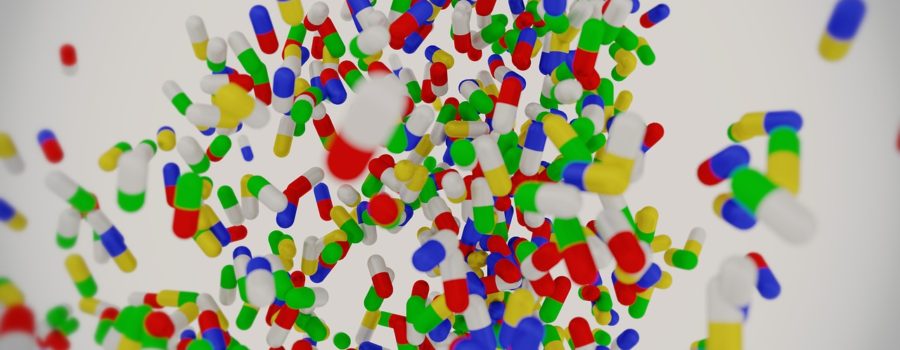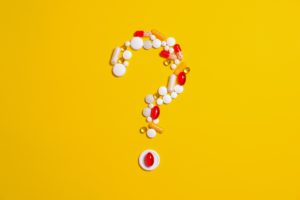Capsule Shells for Medications and Supplements
We often see that some prescription and over-the-counter medications, as well as many supplements, are encased in capsules. For many of us these may seem more appealing compared to the tablets, that can somewhat dissolve in our saliva and yield an unpleasant, bitter taste.
In the previous post I talked about the probiotics. Knowing how useful they could be, I gave my son two capsules one day. As observant as he is, sometimes, he questioned me right-away: “Mom, it’s not quite healthy to drink water from plastic bottles, but it’s OK to swallow these plastic capsules altogether?” Little did he know that I had replaced the plastic capsules shells with non-plastic, gelatin-made ones. I explained my reasons to him and I’ll explain again here.
The hard-shelled capsules, as you’ll see if you check the ingredient lists, can be of two types: gelatin and vegetable. But the vegetable capsules are not really vegetable, just as good a name for them could be “plastic capsules.” Being called vegetable, veggie, vegetarian, and sometimes cellulose capsules, is misleading for most consumers. Although it’s true that one of their main components is cellulose, the other is a petroleum derivative.
To get a bit more technical just for clarity, the material for the vegetable capsules it’s a polymer produced by reacting cellulose fibers with propylene oxide—nothing vegan about this one! The substance resulting from this reaction is called hydroxypropyl methylcellulose or hypromellose. This chemical name is often included in brackets next to vegetarian capsules. The same propylene oxide it’s used to produce plastic #5, also known as polypropylene.
The denomination for the capsules produced using propylene oxide as “vegetable” is not correct, I think, even if it seems more appealing. Sometimes on the ingredient lists there may be more distracting details about the cellulose source (like “pine tree cellulose,” for instance), but this still doesn’t make these capsules non-chemical. Hypromellose capsules can be plain, but can also contain additional preservatives, artificial colors (many being allergy triggers), sodium lauryl sulfate (SLS), carrageenan, and other excipients.
Hypromelloses are incorporated in numerous other tablets, however the amount in the capsule shells is higher than what’s mixed in tablets’ composition. Since I’m already on the topic of hydroxypropyl methylcellulose (HPMC)/hypromellose, I want to point out two more related substances obtained from reacting cellulose with petroleum-derived chemicals, namely hydroxypropyl cellulose (HPC) and carboxymethyl cellulose (CMC)—also known as croscarmellose. They are all generically called semi-synthetic celluloses and are included in numerous medications as inactive ingredients, and in foods.
They are part of a bigger group of chemicals classified “generally recognized as safe”—GRAS—but, based on my experience, I have many doubts that they are. I explained about many of them in the book. The discussion about their safety usually focuses on the fact that the amounts consumed are too low to pose health problems. They’re actually not that low, being included in numerous products; thus far, I don’t think we know their full impact on our health either. For the chemical reactions, it is true that the newly formed products have different properties compared with the chemical parent-components. However, if one looks closer, contaminants and impurities from the manufacturing process are often detected in the final products that reach the consumers.
Suffering of autoimmune arthritis, I realized that certain chemicals, included in everyday products made my joints feel worse. That’s how I started my journey to remove from use as many as I can. At some point, my focus wasn’t propylene oxide, but it appeared that I felt less stiffness during the days when I forgot to take the probiotics “vegetable” capsules. After learning how they were produced, I replaced the so-called “vegetarian” shells with the gelatin ones, and I felt less stiff and achy.
The gelatin capsules aren’t ideal either. They are produced from the collagen proteins derived from animals’ connective tissues (mostly skins and bones, but other tissues can be used as well). This is probably why it’s unappealing to many people who are not even vegetarian. It’s surprising to me though, how people who dislike the idea of gelatin still eat the jiggly gelatin-containing desserts.
For the gelatin capsules, because of the concern about mad-cow disease, some manufacturers provide certifications that their products are free of BSE (bovine spongiform encephalopathy) or TSE (transmissible spongiform encephalopathy). They also disclose their sources (pigs, cows) and what animal parts (skin, bones) they use; retailers may also pass this information onto their sites. Other certifications are Kosher and Halal, because beside a personal or dietary preference, there are also religious reasons why people choose “vegetable” capsules.
Gelatin capsules are no strangers to preservatives, additives and excipients either, but plain ones (gelatin and water), are available. Artificial colors, sodium lauryl sulfate (SLS), and plasticizers can also be added, especially for the prescription medications.
Here is an example of a capsule shell for one of the prescription medications I take, and has the following components: “gelatin, silicon dioxide and SLS added as manufacturing aides to gelatin and titanium dioxide, imprinting ink of n-butyl alcohol, pharmaceutical glaze modified in SD-45, propylene glycol, SDA-3A alcohol, titanium dioxide, D&C yellow No. 10, Aluminum Lake, and FD&C blue No.1 Aluminum Lake.” Do I really need all these? As this is not an extended-release medicine, I transfer the powder into plain gelatin capsules and the therapeutic effects are the same.
Some coatings are helpful in order to have certain medicines escape the stomach acid, bile and pancreatic enzymes; not cause stomach upset; reach the small intestine or colon—where their effect is needed; or have the medicine delivered over an extended period of time. Some prescription medications do need their coatings, but many times, for the same active ingredient, there are available options that don’t require them.
Another issue is that some enteric-coated or the extended-release capsules can be actually coated with plasticizers like phthalates. Their safety—or better said, their un-safety—was studied quite a bit, and in the United States, in 2008, some phthalates were finally banned from children’s toys and baby-bottles. Unfortunately, others are still lurking in numerous consumers’ products. Phthalates, acting as estrogen hormones in our bodies, are linked with fertility and developmental disorders.
Soft gel capsules (sometimes called caplets or liquid gels), are also made from gelatin, but can’t be opened. They are often seen in over-the-counter products, ranging from pain relievers to supplements (vitamin D, fish oil). As opposed to the hard-shelled capsules that can only be filled with powder, the soft gel ones are used for medications that are oily or pasty. Mixing and homogenizing these is done using polyethylene glycol (produced from ethylene oxide)—my bigger nemesis.
Gellan gum capsules are obtained after fermentation of lactose (from whey) or glucose (from corn starch), by a bacteria called Sphingomonas elodea and it’s a carbohydrate our body cannot digest. Beside the possible use in producing capsules, it is also a food additive in bakery products, jams, and candy.
Pullulan capsules are produced from tapioca starch fermented by a fungus called Aerobasidium pullulans—the black yeast; water and carrageenan gum are added to the recipe. This seems truly a vegetarian capsule. However, I never saw the term “pullulan capsule” listed on labels for any of the products I looked at. At this point, since I don’t know enough about these capsules, I prefer to stick to the gelatin ones I know.
Most of the dietary supplements in powder form, can be included in either type of hard-shelled capsules, without changing the properties for the active ingredient. If the taste buds allow it, for many products the capsules can be opened and the content sprinkled over food or juice, unless it’s specified otherwise on the label. Because many consumers, mislead about the name of vegetable capsules prefer these, some manufacturers may unexpectedly change their products. The gelatin capsules are replaced with the “vegetable” ones, which in reality are…..plastic. I had to discover this switch the hard way, with the brand of charcoal capsules I was taking.
Probiotics supplements I’ve seen incorporated in either capsule type. I know that the most commercially available probiotics contain a mix of lactobacilli and bifidobacterium, and most of their strains are resistant to stomach acid, bile, and pancreatic enzymes. It’s sensible to be this way, think about it: they follow the same path as those from the probiotic foods we ingest and end up colonizing our intestine. Our body has the means to allow the beneficial bacteria inside and “dispatch” them where they belong. Moreover, it even makes sense historically. The first time a scientist thought about what we now call probiotics, was in 1907, while analyzing the good health and longevity of bulgarian peasants. He intuitively thought that bacteria from the fermented milk products they were consuming were the beneficial factors. We all know for sure those peasants were so healthy without protecting their probiotics in a capsule!
For certain prescription medications (capsules or tablets), the instructions could be to “swallow as whole,” and is necessary to be taken this way, for the active medication to work. As a rule of thumb, the capsules that are designed as extended-, delayed-, or controlled-release, as well as enteric-coated, are not meant to opened. The tablets with the similar designations cannot be crushed either. The pharmacists usually can answer questions regarding this, for each specific medication.
After reviewing all these facts about medication capsules, trying to minimize the amount of plastic I swallow, I can reveal my approach:
- I ordered clear gelatin capsules from a website that certifies the ingredients are just gelatin and water
- I transfer any powder-form supplement from their vegetable capsule into the plain gelatin ones I bought; to avoid possible additives, I do the same for the supplements in gelatin capsules—from unknown manufacturers
- the probiotics I take by opening the capsules and sprinkling their content over cold or room-temperature food or juice
- for prescription medications (non extended-release) that come in gelatin capsules (usually with numerous additives), I transfer the powder into the plain gelatin capsules
- whenever available, I opt for medications that are not extended-release, but have similar effects, even if they may not belong to the exact same class of medication; one example is replacing Nexium (an acid reducer) with sucralfate (providing a protecting layer inside the stomach, that decreases the irritation from stomach acid)
- as I explained, no soft gel capsules for me: I take the unflavored, sardine tasting fish oil as such, in a teaspoon; I use vitamin D in a drop form and it tastes like the olive oil it’s made of.
If one needs a specific therapy and no other equivalent medication is available, there is not much of a choice. This is unfortunate, especially for daily medications, but for the most part, there are other options. For vitamins and other supplements, decreasing the number of swallowed plastic capsules can be done.



